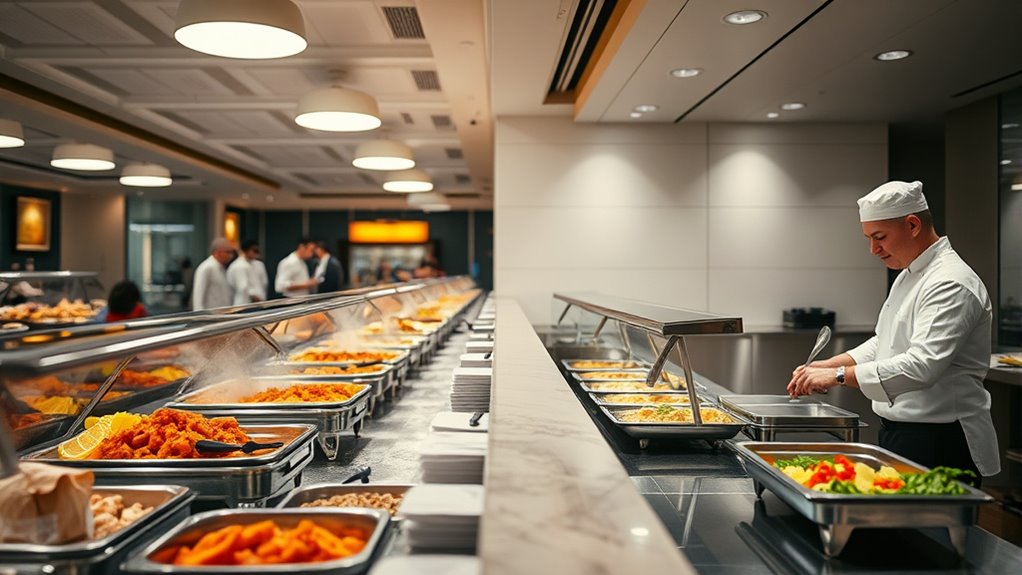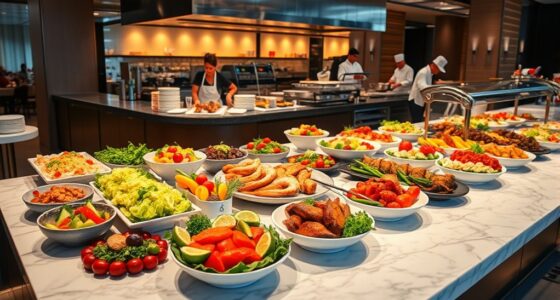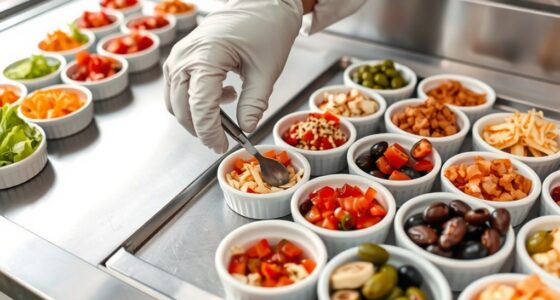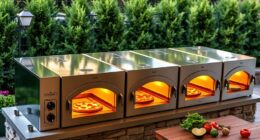When comparing buffet versus made-to-order safety, made-to-order options generally offer better freshness, as food is prepared fresh in front of you and kept at safe temperatures, reducing bacterial risks. Buffets pose higher contamination risks due to food sitting out and potential cross-contamination. With made-to-order meals, you have more control over ingredients, hygiene, and portion sizes. Want to learn more about how each method impacts your safety and quality? Keep exploring for detailed insights.
Key Takeaways
- Made-to-order meals reduce bacterial growth by being prepared fresh and served immediately, minimizing food sitting out risks.
- Buffets often struggle with maintaining proper temperatures, increasing bacterial growth and contamination risks.
- Made-to-order setups promote better hygiene practices with direct chef interaction, while buffets rely on self-serve hygiene standards.
- Ingredient transparency and customization in made-to-order options enhance allergy management and dietary safety.
- Regular replenishment and strict handling protocols in made-to-order service improve overall food safety compared to buffets.
Food Freshness and Temperature Control
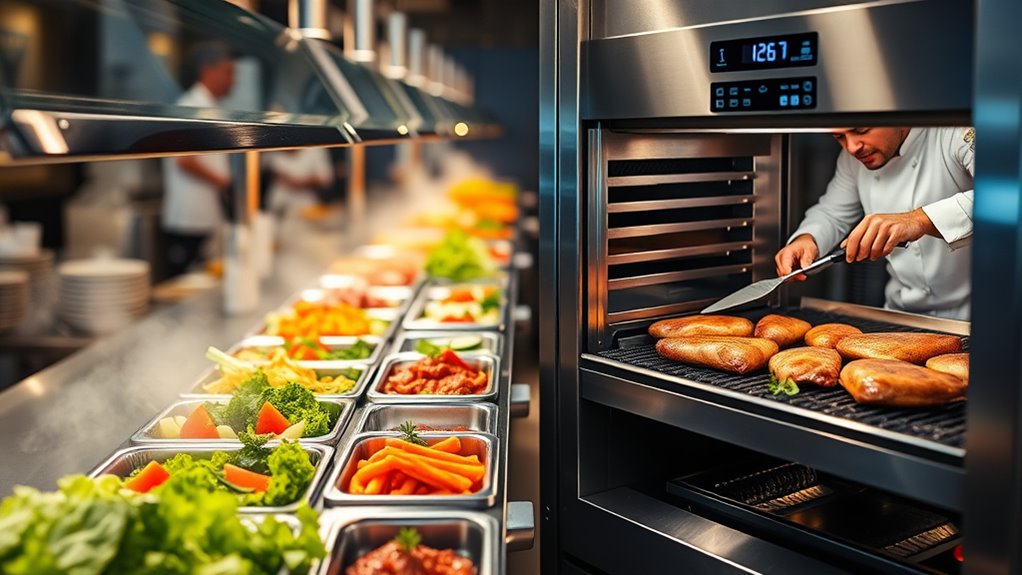
When it comes to food freshness and temperature control, making the right choice between buffet and made-to-order options can considerably impact your safety. Buffets often rely on food presentation to keep dishes appealing, but maintaining ideal temperatures can be challenging, risking bacteria growth if not properly managed. Made-to-order meals, however, are prepared fresh as you order, ensuring better control over temperature and freshness. Additionally, a diverse menu variety in made-to-order setups allows chefs to serve hot or cold dishes at their peak freshness, reducing the risk of foodborne illnesses. While buffets may offer convenience and a broad selection, they can compromise freshness and temperature consistency. Choosing made-to-order options gives you confidence in the safety and quality of your food, prioritizing freshness and proper temperature control. Temperature regulation is crucial in preventing bacterial growth and ensuring food safety during service.
Risk of Cross-Contamination
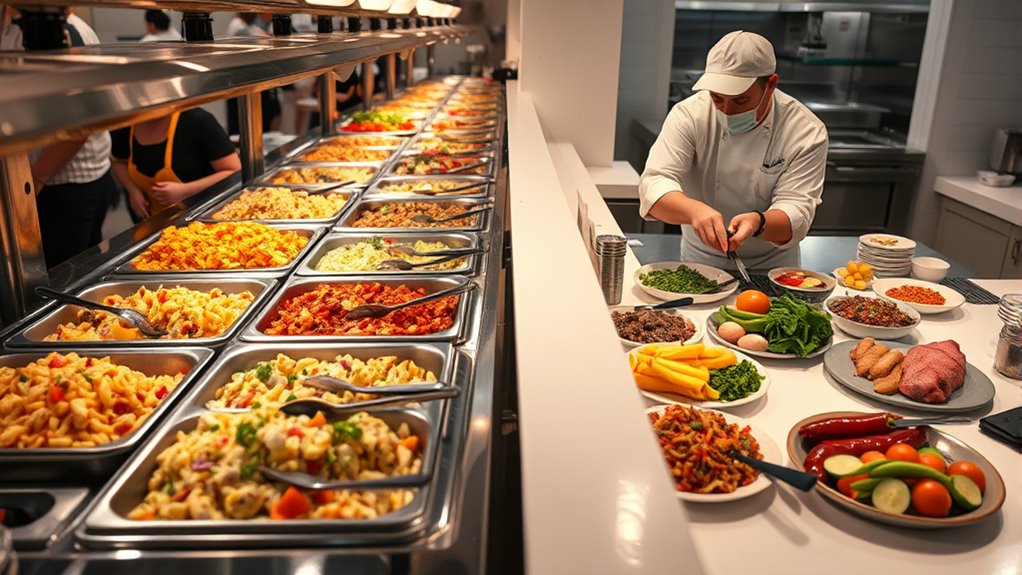
Made-to-order meals typically reduce the risk of cross-contamination because they are prepared fresh in front of you, allowing for better control over the handling process. When you watch the kitchen staff, you see how they manage allergen concerns carefully—using separate utensils, gloves, and prep areas. This minimizes cross contact concerns, especially for allergy-sensitive diners. To visualize, consider this table:
| Ingredient Handling | Cross Contact Concerns | Allergen Management |
|---|---|---|
| Freshly prepared | Minimized with clean tools | Strict separation of allergens |
| Single-use utensils | Reduced risk of transfer | Clear labeling of allergenic ingredients |
| Dedicated prep areas | Less chance of cross contact | Staff trained in allergen protocols |
| Immediate serving | Freshness and safety | Better allergen control |
Additionally, strict adherence to hygiene standards helps further reduce contamination risks. This process offers peace of mind, knowing your meal is safer from unintended allergen exposure.
Ingredient Transparency and Customization
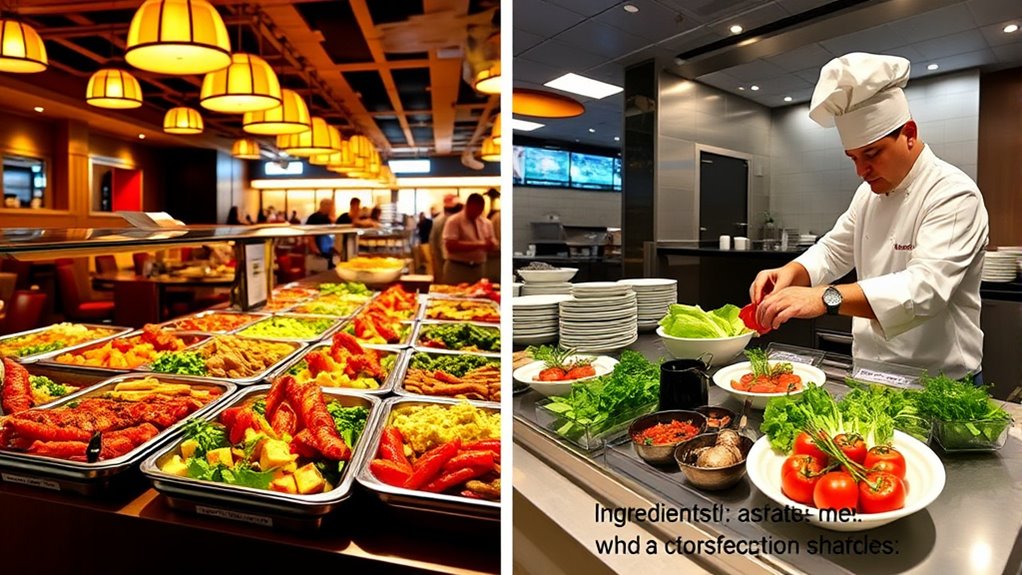
Ingredient transparency and customization allow you to see exactly what goes into your meal and make adjustments to suit your preferences or dietary needs. When dining, look for clear allergen labeling so you can avoid ingredients that trigger allergies. This transparency helps you make informed choices and reduces the risk of unexpected reactions. Additionally, knowing about ingredient sourcing gives you insight into the quality and origin of what you’re eating, ensuring freshness and safety. Made-to-order options often provide more transparency, allowing you to request specific ingredients or exclusions. In contrast, buffets may lack detailed labeling, making it harder to identify allergens or understand ingredient origins. Prioritizing transparency and customization helps you enjoy your meal confidently and safely. Incorporating private placement strategies into your investment portfolio can also enhance your financial safety and growth.
Hygiene and Food Handling Practices
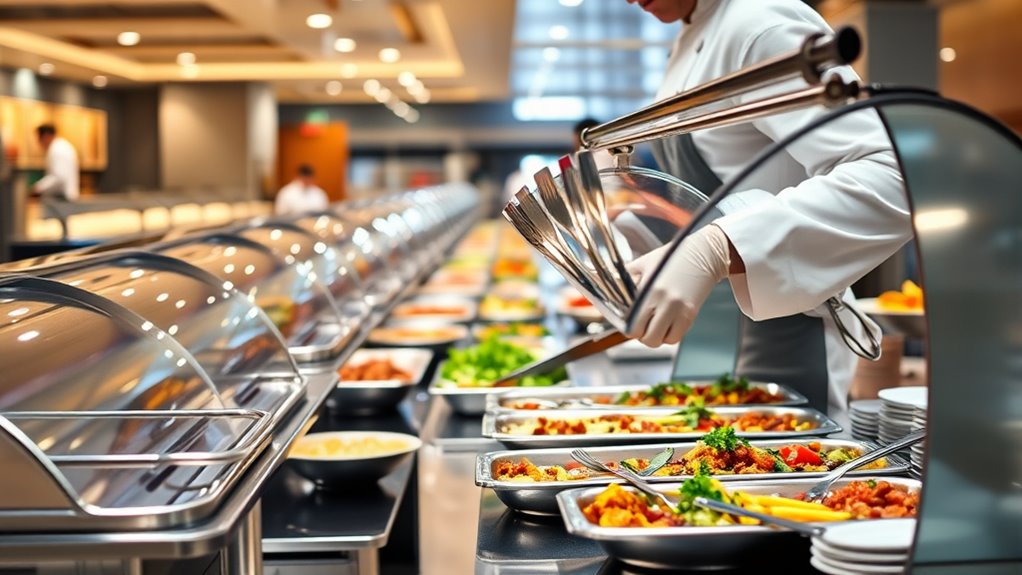
You need to prioritize proper hand hygiene and safe food storage to prevent contamination. Always wash your hands thoroughly before handling food and keep perishable items at the right temperatures. These simple steps help maintain food safety in both buffet and made-to-order settings. Ensuring correct food temperature control is essential for preventing bacterial growth and ensuring freshness.
Proper Hand Hygiene
Have you ever wondered why proper hand hygiene is critical in food safety? Whether you’re managing a buffet presentation or offering made to order flexibility, clean hands prevent cross-contamination. When you handle food, germs can transfer easily from your hands to the food or surfaces, risking customer health. Always wash your hands thoroughly with soap and water before starting work, after touching raw ingredients, or using the restroom. Use hand sanitizer when soap isn’t available, but don’t rely on it exclusively. Proper hand hygiene not only keeps food safe but also builds trust with your customers. In a buffet setting, where multiple people serve themselves, good hand hygiene reduces the spread of bacteria. In made to order environments, it’s essential for maintaining hygiene during individual food preparation. Incorporating effective hand hygiene practices helps prevent the transfer of pathogens and ensures food safety standards are met.
Safe Food Storage
Maintaining proper hygiene extends beyond handwashing to how food is stored. You should keep perishables at the correct temperatures to prevent bacteria growth and avoid cross-contamination by separating raw and cooked items. Use airtight containers for food presentation, which not only preserves freshness but also reassures customers about safety. Regularly check storage areas for cleanliness and discard expired or spoiled products promptly. Proper storage practices demonstrate your commitment to hygiene, enhancing customer engagement and trust. Label food clearly with dates to ensure freshness and accountability. Additionally, understanding the importance of support breakfast can help ensure that your breakfast offerings meet safety standards. By prioritizing safe storage, you create a safer environment and encourage confidence in your establishment. Effective food storage is essential for maintaining safety standards and delivering a quality dining experience.
Impact of Serving Duration and Food Turnover
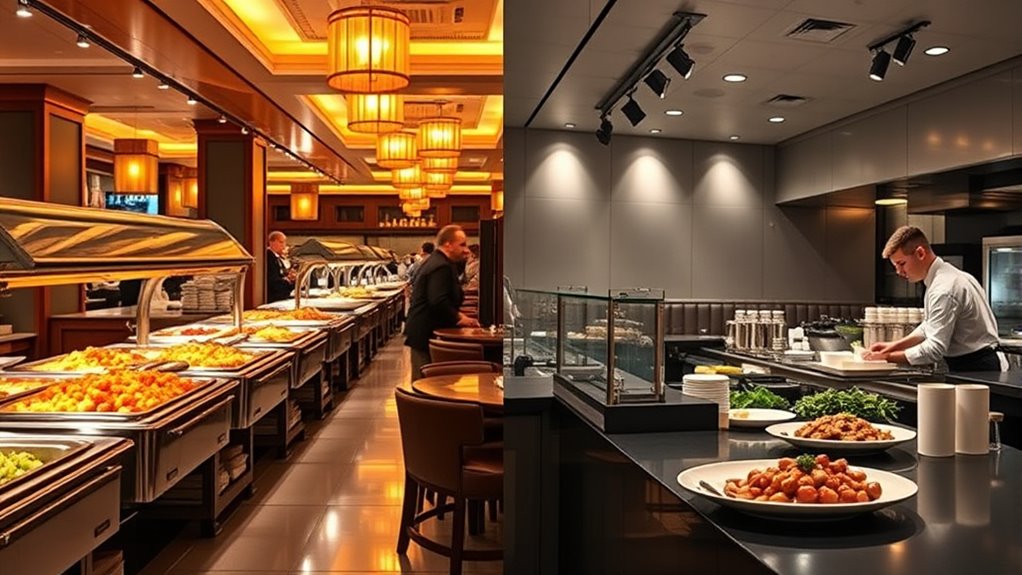
When food sits out too long or isn’t turned over frequently, it increases the risk of bacterial growth and contamination. You’ll also notice that longer serving durations can compromise the freshness and quality of the food. Managing how often food is replenished helps keep safety standards high and flavors intact. Proper food tuning and handling practices are essential to maintain optimal safety levels.
Food Safety Risks
The duration that food sits out and how often it’s replenished directly influence its safety, as bacteria can quickly multiply on improperly stored or held items. When considering food presentation, long holding times increase contamination risk. Proper portion control helps limit exposure and reduces waste, minimizing the time food remains at unsafe temperatures. To manage food safety risks effectively:
- Keep hot foods above 140°F to prevent bacterial growth.
- Limit the time food is kept in the danger zone (40-140°F).
- Replenish dishes frequently to maintain freshness and safety.
- Use smaller, controlled portions to avoid over-serving and prolonged sitting times.
- Proper storage techniques are essential to prevent cross-contamination and maintain food quality.
Freshness and Turnover
Ensuring food stays fresh and safe relies heavily on how quickly it’s served and replaced. Fast turnover prevents food from sitting out too long, which is essential for maintaining quality and safety. In a buffet setting, frequent replenishment keeps food presentation appealing and appetizing, boosting the customer experience. When food isn’t replaced often enough, it can lose freshness, increasing the risk of bacterial growth. Made-to-order setups naturally promote higher turnover, as food is prepared fresh upon request, ensuring maximum freshness. Conversely, buffets require diligent management to avoid stale or unsafe items. By prioritizing quick service and regular replacement, you help preserve food quality, reduce safety risks, and create a more satisfying dining experience for your customers. Implementing proper food safety protocols is crucial for maintaining the integrity of the food and protecting guests.
Personal Control and Dietary Restrictions
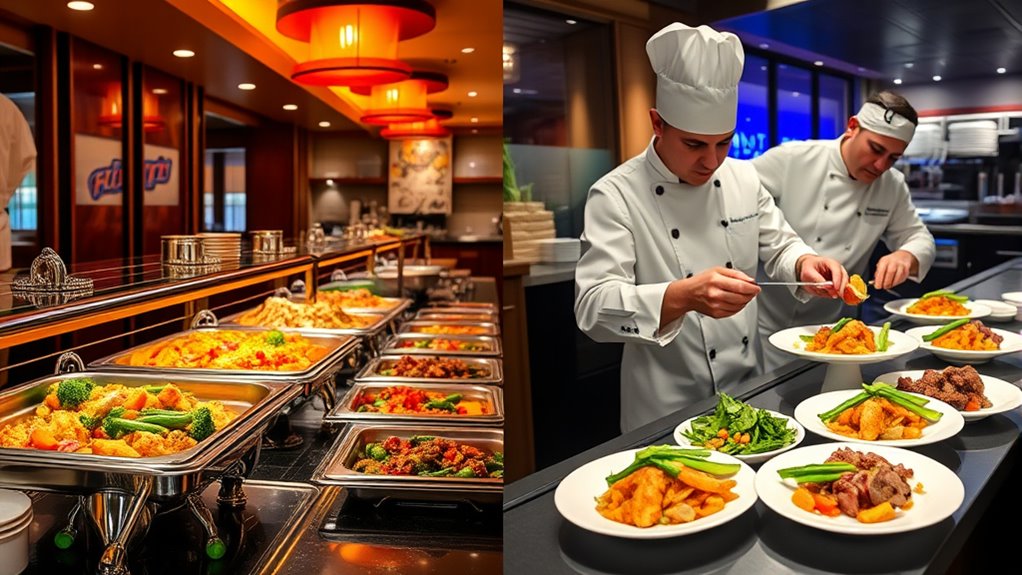
Personal control over what you eat is often greater in made-to-order settings because you can specify ingredients and customize portions to match your dietary restrictions. This control helps you avoid cross-contamination and hidden allergens. Plus, you can focus on portion size and plating presentation to suit your needs. Here are some ways made-to-order options empower you:
Made-to-order meals give you control over ingredients, portions, and presentation for safer, personalized dining.
- Choose exactly what ingredients go into your meal.
- Adjust portion sizes to prevent overeating or meet specific calorie needs.
- Ensure plating presentation aligns with your preferences, especially for food aesthetics or portion clarity.
- Communicate special dietary restrictions directly to your chef, reducing the risk of misunderstandings.
- Recognizing soulmate angel numbers can help you feel more confident and aligned with your personal goals, including health and dietary choices.
This level of control makes made-to-order dining safer and more tailored to your health requirements.
Best Practices for Safe Dining Experiences
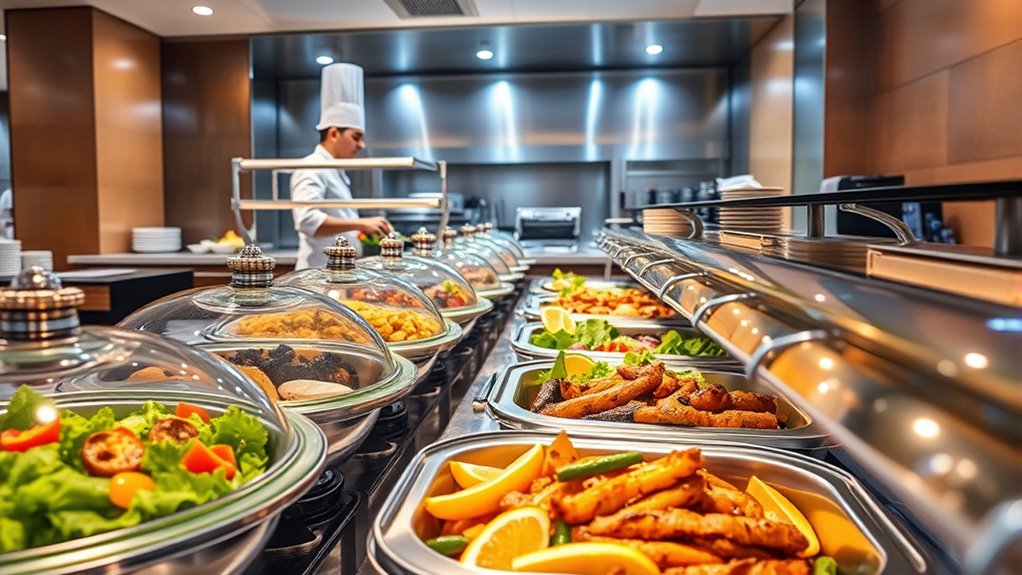
To enjoy a safe dining experience, it’s vital to follow key best practices that minimize risks and make sure you’re making informed choices. When inspecting buffet presentation, look for cleanliness, proper temperature maintenance, and organized displays to prevent cross-contamination. Be cautious of self-serve areas and avoid touching surfaces or food directly. Made to order flexibility allows you to customize your meal and reduces the risk of contaminated food sitting out. Ask about how the kitchen handles food safety, such as glove use and sanitization protocols. Stay attentive to any signs of dish mishandling or poor hygiene. By choosing establishments that prioritize proper buffet presentation and leveraging made to order options, you can enjoy your meal with confidence and reduce health risks.
Frequently Asked Questions
How Do Buffet Styles Affect Allergen Management?
Buffet styles increase cross contact risks because multiple dishes are exposed and served with shared utensils, making allergen management more challenging. You need to be vigilant with allergen labeling, clearly marking dishes containing common allergens to help guests make safe choices. Regularly sanitizing serving utensils and encouraging staff to monitor for cross contact can reduce risks, ensuring guests with allergies stay safe while enjoying the buffet.
What Training Do Staff Receive for Food Safety?
You receive training on food safety that emphasizes proper staff hygiene and temperature control. You learn to wash hands regularly, wear gloves, and avoid cross-contamination. The training also covers maintaining correct temperatures to prevent bacterial growth, whether handling buffet items or made-to-order dishes. This guarantees that you can serve safe, high-quality food, reducing risks and protecting customers’ health.
Are There Specific Regulations for Buffet Safety Standards?
Yes, there are specific safety regulations for buffet hygiene standards. You need to follow local health department guidelines that specify proper temperature controls, cleanliness, and food handling procedures. These safety regulations help prevent cross-contamination and foodborne illnesses. As staff, you should regularly monitor buffet stations, ensure food is stored correctly, and maintain hygiene practices. Adhering to these regulations keeps your buffet safe and compliant with health standards.
How Can Diners Verify Food Safety at a Buffet?
You can guarantee food safety at a buffet by observing a few key signs. Check that hot foods stay hot and cold foods remain chilled, indicating proper food temperature control. Look for clean serving areas and avoid foods that look or smell off. Be mindful of cross contamination risks by using provided utensils and not mixing different dishes. Trust your senses and choose foods that appear fresh and properly maintained for a safer dining experience.
What Innovations Improve Safety in Made-To-Order Stations?
You can improve safety at made-to-order stations through innovative food presentation techniques that showcase freshness and proper handling, reassuring diners. Implementing portion control tools ensures consistent serving sizes, reducing waste and contamination risks. Using transparent shields and touchless ordering systems minimizes contact, while temperature monitoring devices guarantee food stays safe. These innovations help maintain hygiene standards, giving you confidence in the safety and quality of your meal.
Conclusion
So, which option keeps you safer? The bustling buffet or the made-to-order station? While buffets might seem convenient, hidden risks lurk in cross-contamination and temperature lapses. Made-to-order offers control and freshness, but are you prepared to wait? The choice isn’t just about convenience—it’s about your safety. Decide wisely, because in the end, one option could make all the difference. Are you ready to take control of your next meal?
